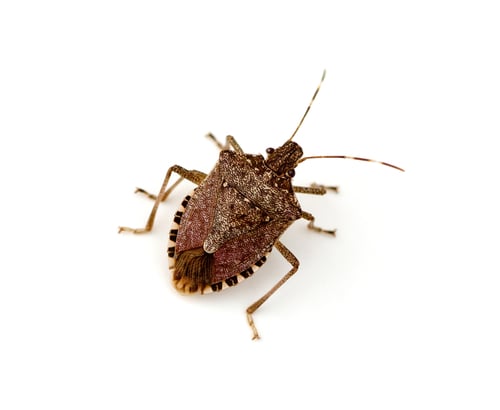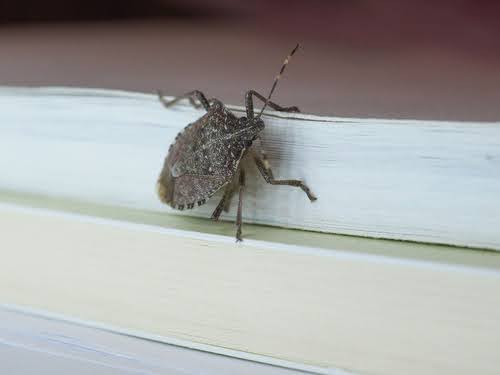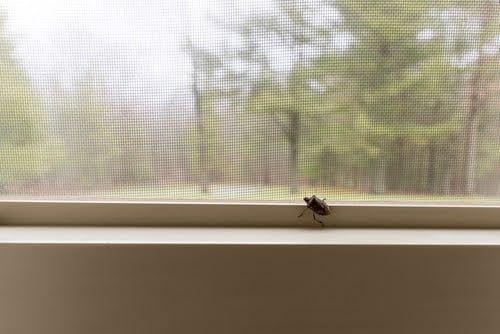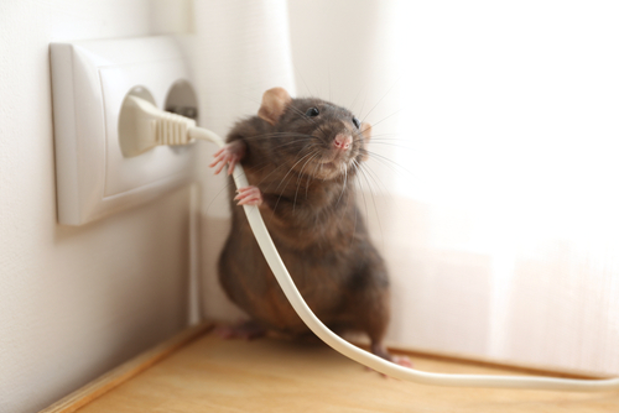During the winter months, stink bugs go into something called “diapause.” Diapause is a hibernation-like state in which stink bugs remain inactive. They huddle in leaf bundles, hollow logs, and other insulated materials until spring. That is unless they find a nice quiet spot in your attic or basement.
The brown marmorated stink bug is an invasive species. If they can find a way in, they will invade your home during the winter rather than braving the outside elements. So, how do you keep these pests outside and avoid a stink bug infestation? Read our blog to learn more about how to prevent these pesky pests:
Do I Have Stink Bugs in My House? What Do They Look Like?

To know if you have a stink bug problem in your house, you need to know what they look like. Brown marmorated stink bugs are grayish-brown in color with hints of red or dark green. Their bodies are triangular, or shield-shaped. They have antennae with light bands and often have a light band around the edge of their abdomen.
An adult female will lay 20-30 eggs in the spring which hatch into tiny yellow and red colored nymphs with red eyes. These nymphs will molt or shed their exoskeleton five times before becoming winged adults. During each molt the nymphs become larger and grayer.
Avoiding an Infestation: Why Do I Need to Keep Stink Bugs Out of My House this Winter?

Although stink bugs aren’t dangerous to humans, they are a nuisance because of the odor they emit when threatened or attacked (which is where their name comes from). Allowing a few stink bugs into your home may not seem like a big deal, but the problem arises when they alert their overwintering spot to others. Stink bugs emit a pheromone, unrelated to their stink gland, that attracts other stink bugs to them.
Additionally, swarms of stink bugs are an agricultural threat. They can cause significant damage to food crops, especially fruit, berries, and beans.
How Do Stink Bugs Get Inside?
Stink bugs enter homes through cracks, windows, doors, and vents. Once inside, they often hide in quiet places like attics and basements. If you see them out and about, it’s likely they are looking for a sunny spot to soak in some warmth.
How to Prevent Stink Bug Infestation in Your Home This Winter

Repair Pest Entry Points
To intercept a stink bug, you need to identify and seal pest entry points. Repair any torn screens and use silicone caulking to close cracks in the following areas:
- Your home's foundation
- Around doors and windows
- On chimneys
- Along vents
- Around utility pipes
Adjust Your Home’s Lighting
Stink bugs are attracted to white lights; minimize a stink bug’s visibility to your home by closing your shades and curtains at night. Use yellow bulbs in your outdoor lights.
Take Away Their Food Sources
Stink bugs don’t eat during diapause. However, they may initially be attracted to food in your home. Keep food containers sealed and your garbage covered to minimize attraction.
What Do I Do If I Find Stink Bugs in My House?
If you take these preventive measures and you still discover stink bugs in your home, don’t squish them—if you do, you’ll unleash their pungent odor. The easiest way to remove stink bugs is by vacuuming them up. Ideally, use a vacuum with a bag that you can remove and dispose of immediately afterward.
Keep Your Space Free of Winter Invaders. With Plunkett’s, Your Home Will Be Stink Bug-Free.
A surefire way to get rid of (and prevent) stink bugs is to hire a professional pest control company. Plunkett’s can safely and effectively remove stink bugs—and other pests—from your home so you can have peace of mind this holiday season. Get in touch with Plunkett’s today.









